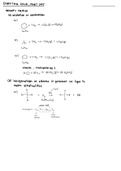Sn1 reactions Study guides, Class notes & Summaries
Looking for the best study guides, study notes and summaries about Sn1 reactions? On this page you'll find 99 study documents about Sn1 reactions.
Page 3 out of 99 results
Sort by
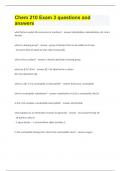
-
Chem 210 Exam 3 questions and answers
- Exam (elaborations) • 11 pages • 2023
-
Available in package deal
-
- $14.99
- + learn more
what factors explain the outcomes of reactions? hybridization, delocalization, eN, atom density what is a leaving group? - group of atom(s) that can be stable on its own - eN atoms that are good LG also make strong acids what is the α carbon? C directly attached to leaving group what are β Cs? β Hs? βC: C(s) attached to α carbon βH: H(s) attached to βC what is a LB? is it a nucleophile or electrophile? lewis base, nucleophile what is nucleophilic ...
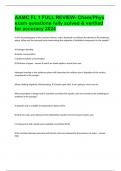
-
AAMC FL 1 FULL REVIEW- Chem/Phys exam questions fully solved & verified for accuracy 2024
- Exam (elaborations) • 24 pages • 2024
- Available in package deal
-
- $14.99
- + learn more
In the chromatography of the reaction mixture, water absorbed on cellulose functioned as the stationary phase. What was the principal factor determining the migration of individual components in the sample? A.Hydrogen bonding B.Solute concentration C.Stationary phase concentration D.Thickness of paper B and D are dumb options. Knock them out. hydrogen bonding to the stationary phase will determine the relative rate of migration of the various components in the sample. When thinking ...
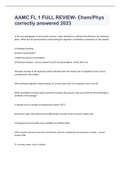
-
AAMC FL 1 FULL REVIEW- Chem/Phys correctly answered 2023
- Exam (elaborations) • 24 pages • 2023
- Available in package deal
-
- $19.99
- + learn more
AAMC FL 1 FULL REVIEW- Chem/Phys correctly answered 2023In the chromatography of the reaction mixture, water absorbed on cellulose functioned as the stationary phase. What was the principal factor determining the migration of individual components in the sample? A.Hydrogen bonding B.Solute concentration C.Stationary phase concentration D.Thickness of paper - correct answer B and D are dumb options. Knock them out. hydrogen bonding to the stationary phase will determine the relative rat...
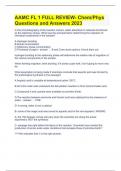
-
AAMC FL 1 FULL REVIEW- Chem/Phys Questions and Answers 2023
- Exam (elaborations) • 17 pages • 2023
-
Available in package deal
-
- $22.49
- + learn more
AAMC FL 1 FULL REVIEW- Chem/Phys Questions and Answers 2023 In the chromatography of the reaction mixture, water absorbed on cellulose functioned as the stationary phase. What was the principal factor determining the migration of individual components in the sample? A.Hydrogen bonding B.Solute concentration C.Stationary phase concentration D.Thickness of paper B and D are dumb options. Knock them out. hydrogen bonding to the stationary phase will determine the relative rate of migrati...
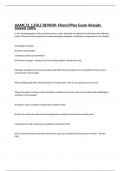
-
AAMC FL 1 FULL REVIEW- Chem/Phys Exam Already Solved 100%
- Exam (elaborations) • 25 pages • 2023
-
- $15.99
- + learn more
In the chromatography of the reaction mixture, water absorbed on cellulose functioned as the stationary phase. What was the principal factor determining the migration of individual components in the sample? A.Hydrogen bonding B.Solute concentration C.Stationary phase concentration D.Thickness of paper - Answer B and D are dumb options. Knock them out. hydrogen bonding to the stationary phase will determine the relative rate of migration of the various components in the sample. When...
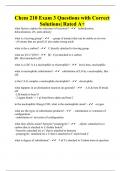
-
Chem 210 Exam 3 Questions with Correct Solutions| Rated A+
- Exam (elaborations) • 9 pages • 2023
-
Available in package deal
-
- $10.99
- + learn more
what factors explain the outcomes of reactions? - hybridization, delocalization, eN, atom density what is a leaving group? - - group of atom(s) that can be stable on its own - eN atoms that are good LG also make strong acids what is the α carbon? - C directly attached to leaving group what are β Cs? β Hs? - βC: C(s) attached to α carbon βH: H(s) attached to βC what is a LB? is it a nucleophile or electrophile? - lewis base, nucleophile what is nucleophilic ...
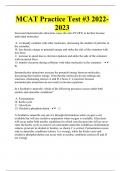
-
MCAT Practice Test #3 2022-2023
- Exam (elaborations) • 35 pages • 2023
-
Available in package deal
-
- $11.99
- + learn more
Increased intermolecular attractions cause the ratio PV/(RT) to decline because individual molecules: A. eventually combine with other molecules, decreasing the number of particles in the container. B. lose kinetic energy to potential energy and strike the side of the container with less force. C. increase in speed due to electron repulsion and strike the side of the container with increased force. D. transfer electrons during collisions with other molecules in the container. - B. ...
These are class notes for CHEM 108, the second exam, in Dr. Mirafzal's class.
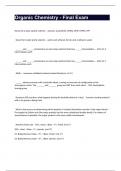
-
Organic Chemistry - Final Exam
- Exam (elaborations) • 7 pages • 2023
-
- $8.49
- + learn more
Organic Chemistry - Final Exam Name the 6 polar aprotic solvents - acetone, acetonitrile, DMSO, DMF, HMPA, THF Name the 5 polar protic solvents - acetic acid, ethanol, formic acid, methanol, water ______ and ______ mechanisms are two step reactions that have _____ intermediates. - SN1; E1; 2 Intermediates each ______ and ______ mechanisms are one step reactions that have _____ intermediates. - SN2; E2; 1 Intermediate each Allylic - resonance stabilized (carbon bonde...
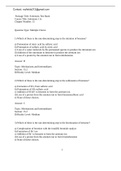
-
Package Title: Solomons Test Bank Course Title: Solomons 11e Chapter Number: 15
- Exam (elaborations) • 119 pages • 2022
-
- $10.89
- + learn more
Package Title: Solomons Test Bank Course Title: Solomons 11e Chapter Number: 15 Question Type: Multiple Choice 1) Which of these is the rate-determining step in the nitration of benzene? a) Protonation of nitric acid by sulfuric acid b) Protonation of sulfuric acid by nitric acid c) Loss of a water molecule by the protonated species to produce the nitronium ion d) Addition of the nitronium to benzene to produce the arenium ion e) Loss of a proton by the arenium ion to form nitrobenzene Answer: D...



